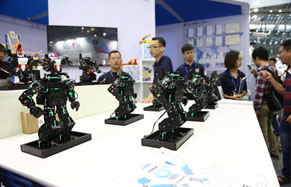Changchun New Area, powerhouse for Chinese economy
Changchun New Area has mapped out a brilliant future: as a national-level new area, a free trade experimental area, and a key hub in China’s opening-up to the world. It will play a pivotal role in implementing China’s Belt and Road Initiative. Now the area has embarked on its journey to becoming a powerhouse for the domestic economy and will spearhead the extension of China’s global connections.
At an auto parts factory in Changchun, engineers stood in front of a desk with a small display screen hung on the wall. They touched the screen every now and then while dealing with the parts and containers. On the screen, information about the engineer and the parts, his or her working time, quantity of tasks and the amount of standard and substandard products is displayed. It is the intelligent factory management
system, developed by Changchun E-Plus Technology, a Changchun-based startup founded in 2015 by a group of former senior managers of auto parts factories.
Wang Wenbo, assistant general manager of the company, said that in the past, managers had to gather workers every morning to distribute the workload, which felt like a waste of time.
"We aim to revolutionize old methods and update our databases with a small screen and the internet," he said. "It will significantly improve efficiency, reduce the cost of management and save paper used to record all the information before."
The intelligent factory management system is the result of efforts to innovate the traditional industries of Changchun, capital of Northeast China’s Jilin province.
The city is known as a base for top automobile brands like China FAW Group Corporation. It is also home to the 70-year-old Changchun Film Studio, Changbai Mountain and extreme cold, falling to minus 20 C in winter.
Last year saw Changchun step into a new development phase once the State Council approved construction of Changchun New Area in February, the 17th national new area since Shanghai’s Pudong New Area was approved in 1992.
According to a statement published on the official website of the State Council on Feb 15 last year, the new area comprises four districts of Changchun with a planned area of 499 square kilometers, aiming to promote the Belt and Road Initiative and revitalize the economy of northeastern China.

Party Chief of Changchun New Area Sun Yaming said northeastern China is now confronted with an economic downturn. "Though we have some traditional industries which are well-known throughout the country, the scale and clustering of the industries are limited," he said. "The transformation of the industrial structure is still a heavy task."
"These problems are common in northeastern Chinese cities, hampering economic growth." Sun expects innovation to drive the new area’s growth.
"Innovation should be emphasized not only in the development of industries, but also in business models, as well as city’s construction and management mechanisms," he said. "The new area is an innovative platform. There is no need to follow any fixed mode."
He said they would use new technology to cultivate three of its major industries, including high-end manufacturing, modern agriculture and modern services.
"Changchun has a long history of producing and studying automobiles. We can apply state-of-theart information technology to the production of automobiles," he said. "We can also use Internet Plus technology in the research and development of satellites, airplanes and robots to promote the high-end manufacturing industry," he said.
He said innovation in agriculture could also be boosted through introduction of international agricultural enterprises, including Sinobioway Group and Heilongjiang Beidahuang Agriculture Co, to develop higher-quality food and urban agriculture equipped with modern management and production mechanisms.
The city’s scientific strength provides more opportunities for innovation. It has three national laboratories, 34 national parks and bases and many scientific institutes and universities, including Jilin University and the four institutes of the Chinese Academy of Sciences, fostering high-level professionals every year, he said.
China’s first self-made high-resolution commercial satellite, the JILIN-1 Satellite, was launched in October, 2015 by Chang Guang Satellite Technology, located in Changchun New Area. It is the first satellite named after a province. The company was founded by Xuan Ming, former president of the Changchun Institute of Optics, Fine Mechanics and Physics, Chinese Academy of Sciences.
The statement by the State Council also indicated that Changchun New Area has a unique geographical position with great potential for businesses looking to go global.
Located in the center of Northeast Asia and the Bohai Bay Rim, Changchun has strong connections with Mongolia, Russia, Japan, the Republic of Korea and many European countries.
Sun said: "Northeast Asian countries are rich in resources and develop their economies quickly. We hope to promote trade with these countries."














